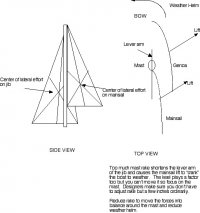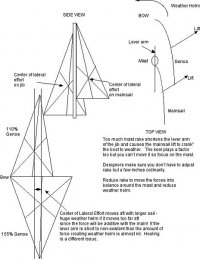Mast rake and weather helm
I made a quick and dirty diagram of what is going on here.
Basically, imagine forces around the mast wanting to twist to windward (weather helm) and away from the wind (lee helm).
The length of the lever is the distance from the Center of Lateral Effort of each sail to the vertical pivot (which for this discussion we'll assume it's the mast - close enough).
Force multiplied by lever arm length is TORQUE. To tune the boat properly, balance the forces. Torque in one direction can be balanced with torque in the other direction (see diagram).
Mast rake is only one of the tweaks. On the Ericson 28+, the mainsail is a big powerhouse so you have to flatten it in heavier air. Do this before you go to a reef. Remember, full sails make horsepower but they also make for heeling moment. Flatter mainsails move the lift vector so that it aims more forward than athwartship. To flatten the main, increase the outhaul and the cunningham (or halyard tension if no cunningham). Remember to ease the topping lift and sheet that puppy in. She'll stand up.
The same should be done for the jib. Increase halyard tension, which moves the sail draft forward and the resulting lift vector will move forward too, thus reducing heeling moment.
I hope this helps. If it is more confusing, then rag on me and I'll seek to clarify. email me at
nickhandres@comcast.net if you want.

SV Rascal
Ericson 28+ #25310




